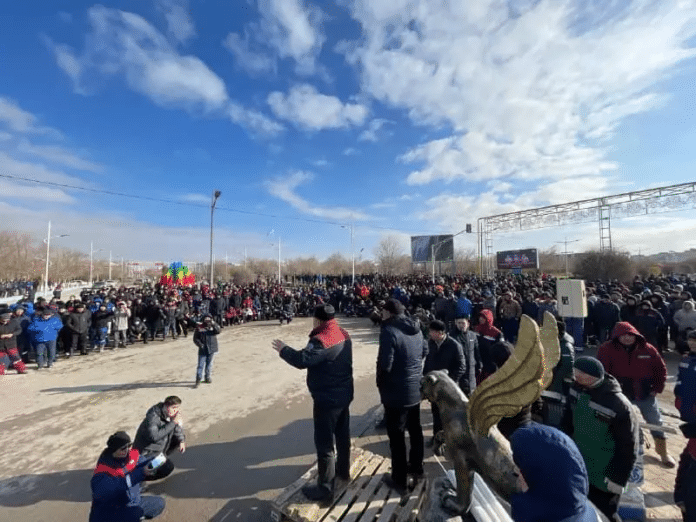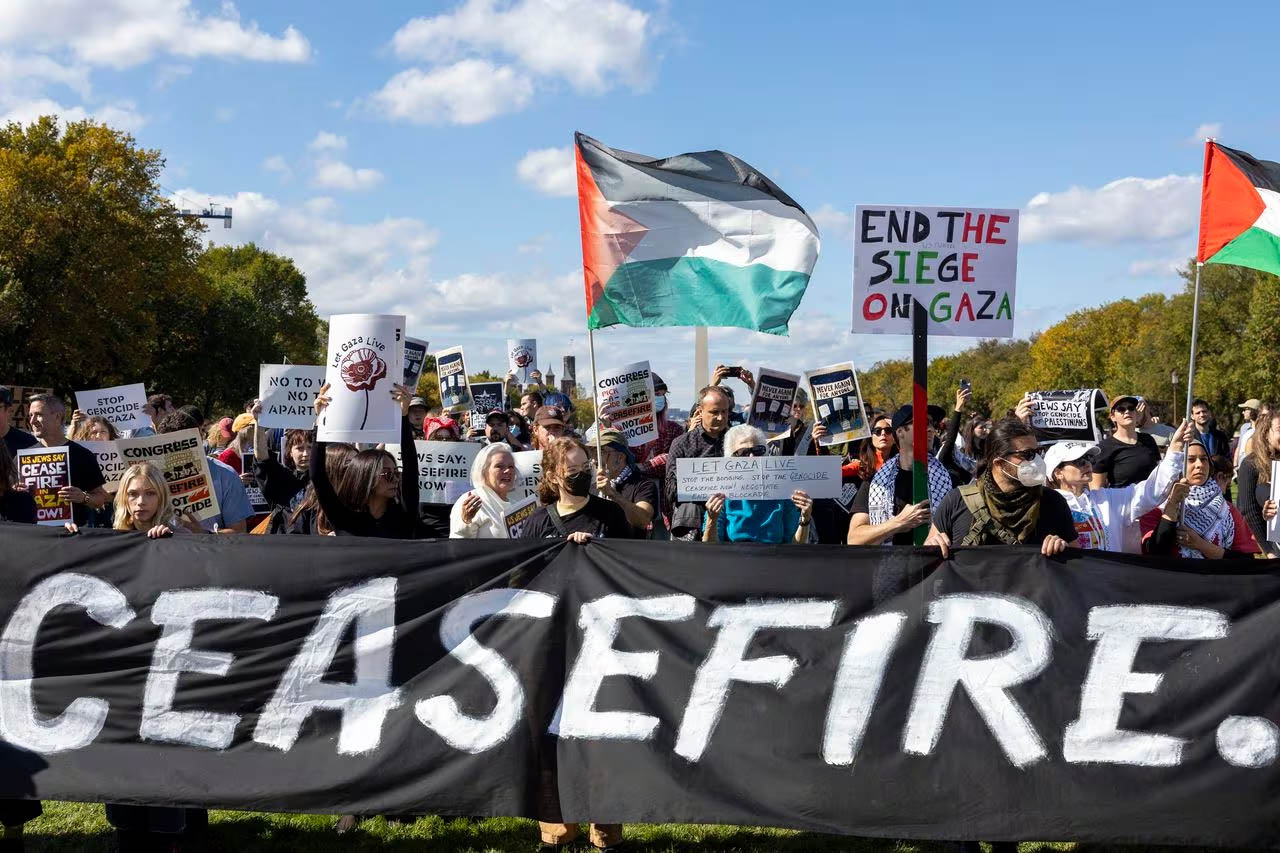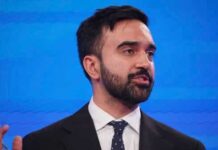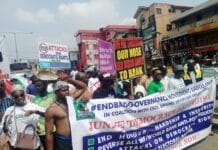Revolutionary events such as those that have taken place in Kazakhstan over the last couple of days have their own dynamic — once started they are difficult to stop. Now dozens have been killed and thousands arrested as foreign troops arrive.
Sotsialisticheskaya Alternativa (ISA Russia) reporters
Revolutionary events such as those that have taken place in Kazakhstan over the last couple of days have their own dynamic — once started they are difficult to stop. On Tuesday evening, President Tokayev appealed for calm and dialogue on television, within hours he had sacked the government and appointed a new Premier. A Deputy Premier and State Secretary, two leading officers of the KNB, once called KGB, were also announced. On Wednesday afternoon, protesters ransacked the building of the KGB in Almaty. Overnight — Wednesday to Thursday — fighting in Almaty’s city centre continued. Reports indicate that snipers on roofs were shooting at passing cars while, according to official reports, tens of protesters were killed.
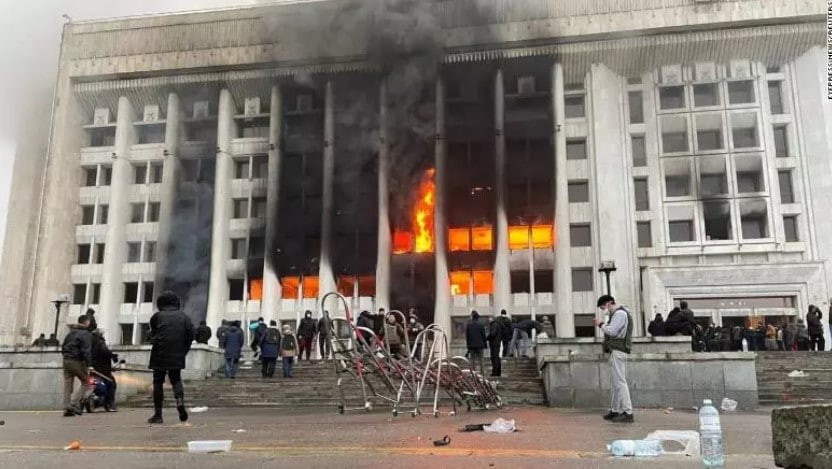
Late Wednesday evening reports emerged that Tokayev had appealed to the “Collective Security Treaty Organisation” (CSTO) to send military forces to help put down, what he called “terrorist groups” who had “received extensive training abroad”. The CSTO includes Armenia, Belarus, Kazakhstan, Kyrgyzstan, Tajikistan and, of course, Russia. Thursday morning it was reported that the CSTO was sending “collective peacekeeping forces… for a limited period of time to stabilize and normalize the situation” caused, it claimed, by “outside interference”.
This was said by Nikol Pashinyan, Armenian President who just a year ago was complaining that CSTO had not supported Armenia in its conflict with Azerbaijan. He claims to be the strongest supporter of democracy in the region. Yet he sees nothing wrong with sending troops to a neighboring dictator to put down the working class.
Now three thousand Russian troops supported by tanks and heavy artillery are on their way “to help guard state buildings”, supported by more from Belarus. Both Tajikistan and Armenia have also agreed to send troops, but Kyrgyzstan seems to be refusing and official statements say that even if they do send troops, they will not be allowed to act against protesters. The Union of Turkic States has said it is willing to help the Kazakh government.
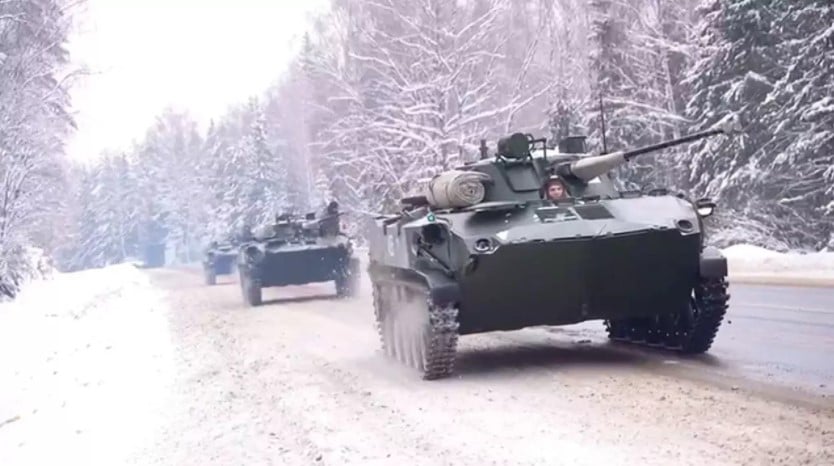
Protests across a country the size of Western Europe
There has barely been a major city untouched by unrest. What started as protests by oil-workers and their supporters in Mangystau in West Kazakhstan within hours spread across the 3500km wide country. Scenes have been remarkable. In some cities, police vehicles and buildings were attacked. Workers blockaded the main railway lines to prevent police and troop movements, while in Taldygordan, crowds heaved ropes around the statue of the hated Nursultan Nazarbayev and hauled it down.
In scenes reminiscent of those in the Egyptian uprising at the start of the Arab Spring, in several cities administration buildings were seized or set ablaze. In Almaty, the biggest city, the Mayor’s office, not so long ago the National Parliament, the KNB headquarters, and the party headquarters have been invaded and set alight. A few dozen protesters took over the city’s International Airport after the troops protecting it left.
In Atyrau, protesters cheered while the hated riot police came out of their building and joined the protests. Elsewhere there are videos of troops fraternising with the protesters, or of troops being disarmed sometimes en-masse by the crowds.

“We are not terrorists”
It doesn’t take long in such situation for the regime to blame the protesters for violence. Tokayev’s speeches now are full of words such as “terrorists”, “looters”, “rioters”, “criminal groups” and, of course “foreign agents”. In the latest reports they have started to notice “Islamic extremists”. Tokayev claims now that Almaty is under siege by terrorist groups.
Indeed Russian state news in covering the dispatch of troops is showing blood-curdling footage from Kazakhstan blaming everything on “Islamic extremists” and “foreign intervention”. Without mentioning the deaths of dozens of peaceful protesters, it reports that thirteen police have died — two of them beheaded!
Even some left wing sites have fallen for the propaganda. One site reports:
“A group of demonstration [sic] opened fire on national Guard forces outside Almaty’s administration building. There are some wounded among the security forces…. Protesters looted… Oppositionists are holding lots of weapons…”.
It goes on to repeat the regimes statistics on damage done to property but does not once mention the dozens of protesters killed, or the way provocateurs are being used.
The real situation is described by one correspondent from Almaty:
“On the approach to the square, protesters were collecting rubbish, clearing up after the night’s pogrom…. everything around was quiet, apart from a few provocateurs trying to create a conflict…. in the corner a coordinator was hastily getting a team together, of activists, to define demands — against the intervention by CSTO, against the shut down of the internet, no shooting at civilians, resignation of the government and formation of a provisional government, free political prisoners, set up a squad to ensure discipline and fight looters…”.
Twenty minutes later, without warning, the police opened fire killing at least one twenty year old. This is why some protesters now carry placards saying “We are ordinary people, we are not terrorists”.
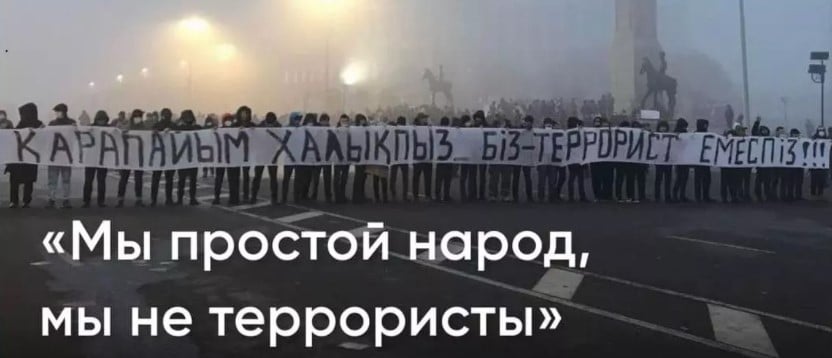
International organisations too are warning about violence as if the guilty are on both sides. The European Union calls “on all concerned to act with responsibility and restraint and to refrain from actions that could lead to further escalation of violence” while pro-capitalist media use phrases such as “violent clashes continue between protesters and the police and army” — all of them putting, at best, equal signs between the two sides, and usually placing protesters first in the list. Yet as the tik-tok produced by Sotsialisticheskaya Alternativa shows — the violence is one-sidedly the responsibility of the Kazakhstan state. The tik-tok can be viewed here and the text in English can be found in the box.
Text of the tik-tok
Across Kazakhstan there are attempts to take over government buildings — the ‘Akimats’.
The police respond with flashbang grenades and tear gas.
In Zhanaozen where the protests started and the demands were first raised, calls are made at the demonstration for coordination councils to be set up.
The most serious clashes with the armed forces take place in Almaty.
The army has been brought into the city.
The office of the ruling party “Nur Otan” in Almaty has been wrecked.
Attempting to resist pressure, the protesters have burnt cars and attempt to intimidate the police.
While the Almaty Akimat was being taken, a fire broke out.
Protesters have disarmed the police with bare hands.
In Almaty the military have had no choice but to travel around in convoys.
In Aktobe the protesters also tried to take the Akimat.
There were more than ten thousand people in the square.
But the police replied with harsh measures.
The conflict is now in a dead end. The regime is in a stalemate.
At the same time people are in solidarity. The video is from the market in Aktobe where stall holders are packing lunches for the protesters.
In Aktau protesters have disarmed a lorry full of the military.
Metalworkers in Balkhashe who have come out on strike are met as heroes.
In Taldykorgan the demonstrators spent several hours dismantling the statue of Nazarbayev, which fell to the sound of the national anthem.
In the end they brought him down. Victory to the protests!
Who is behind the “looting”?
Tokayev has claimed that “terrorists” are seizing buildings and infrastructures and “premises where small arms are located”. What he didn’t say was the main source of weapons was the KNB headquarters, and that just before the building was raided those who were in it were told to go home for the night — a strange order in the middle of an uprising. This is just one example of what appears to be the work of agent-provocateurs. In other cities, there are reports that demonstrations had taken place peacefully before groups of unknown people joined in at the end to start attacks.
In Almaty itself, press reports suggest that the protesters during the day would be chanting slogans, but as they left, they were replaced by men dressed in sports costumes, and that for some strange reason the police withdrew while they went around attacking shops. Press photographs of premises that were supposedly looted showed that windows had been broken, but nothing stolen. This is a tactic that has been used time and again in this part of the world, whether during the Kyrgyz colored revolution, the Russian intervention in Ukraine, or during the revolutionary events in Belarus. The violence used by these provocateurs is then used as an excuse to attack the protesters.
What is behind the protests?
On the surface, the immediate cause of the protests was the increase in the gas price, a decision which the government quickly withdrew. In reality, what has exploded now has been discontent that has built up over decades, but has been brought to a head by the pandemic.
Harsh quarantine measures have drastically affected incomes. The working class have long suffered brutal neo-liberal attacks on their living standards, and in Mangystau, at the end of last year, tens of thousands of oil workers were made redundant. They have been joined in the last year by sections of the middle class as their incomes have proved less stable, and credit conditions worsened. The proportion of the population who believe that the economic situation will improve has fallen from 50% in 2019 to 30% now. But the discontent is multiplied by the widespread corruption and state repression.
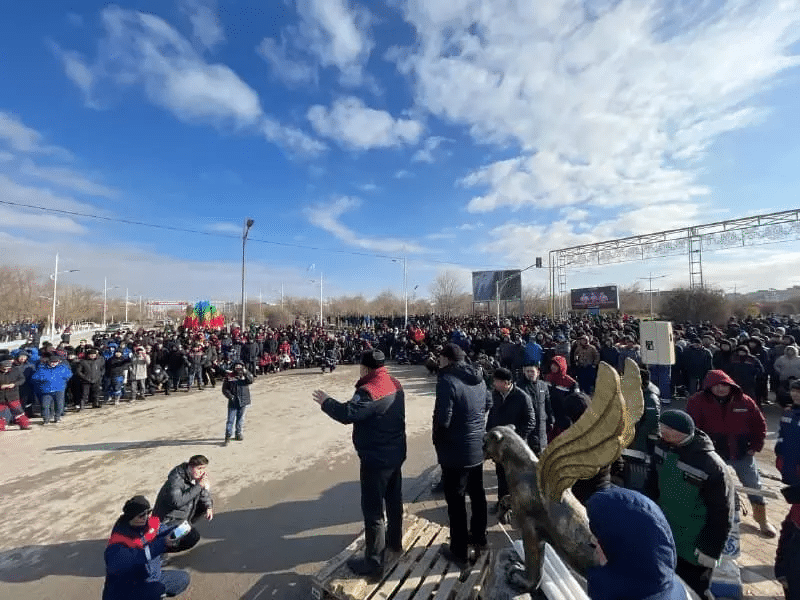
The regime, like the Russian and Belarusian regimes are, despite the outer attributes, built on very unstable and narrow foundations. They have stripped out any opposition forces that can channel discontent and concentrated all power and resources into the hands of a very narrow ruling elite. Figures who could potentially head bourgeois opposition forces like former premier Akezhan Kazhegeldin or the oligarch Mukhtar Ablyazov, facing criminal charges, have been forced into emigration. Any attempt to form independent trade unions has been forcibly suppressed.
Nazarbayev’s role
Nursultan Nazarbayev, former leader of the Kazakhstan Communists in Soviet times, and then President of the Republic of Kazakhstan stepped down from the position in 2019, but in no way did he relinquish the levers of power. Although Tokayev became President, Nazarbayev remained Chair of the Security Council and maintained control of large shareholdings particularly in the oil and gas companies. Most of those who occupy senior posts in the state structures own their allegiance to him still.
If there is a conflict within the regime, it is because Tokayev has not been able to build his own base of support within the regime. The Russian RBK news agency comments: “the state apparatus has [because of this] been destabilised, especially at the top level, with the manoeuvring of high ranking chinovniks between the ‘Akorda’ [President’s residence] and the ‘Bibleoteka’ [Nazarbayev’s office] and this has had a negative effect on all spheres of activity of the Kazakhstan state and society. This became especially clear in 2020 at the peak of the pandemic.”
On Wednesday, Tokayev’s announcement that he was now taking over as Chair of the Security Council in this context marked a serious blow to Nazarbayev’s power. It did not, though, assuage the mass of protesters who, although they had been chanting “Shal, ket!” — “Grandad — go!”, could also sometimes be heard chanting in the plural — they should all go. This is the basis behind the suggestion made by some, that the ‘looters’ active in Almaty were members of sports clubs controlled by Nazarbayev, used as a warning to Tokayev not to go too far.
Leadership vacuum
This would not be possible, of course, if the protests had a clear leadership and demands. Different political forces do try and present themselves as leading the movement from right wing Kazakh nationalists to the exiled oligarchs, such as Ablyazov, who has claimed that he has been preparing this for years! Various supporters of the regime claim that they have found the organizing centre of the protests in Kiev, or somewhere in Europe, or in the US State Department.
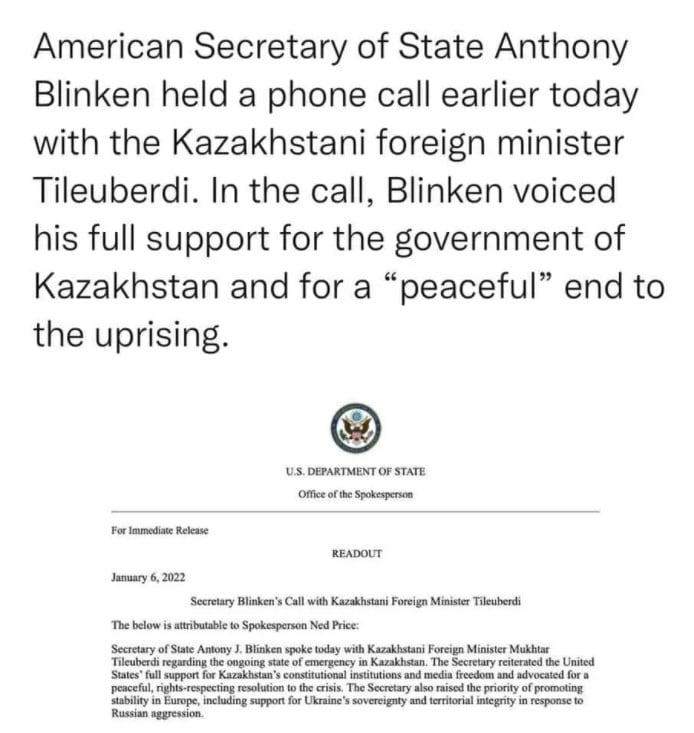
Leader of the Russian “Communists” Gennady Zyuganov claims that this is the work of “those forces that have declared a hybrid-war against Russia”, while Communist Deputy Renat Suleimanov justifies the use of Russian troops to put down the protests because if “the situation in this country [Kazakhstan] is destabilized, Russia will face a serious threat”.
Role of working class
It still remains the case however that the best organized and the clearest calls are coming from the workers’ movement in Mangystau, and Zhanaozen in particular. Even the city’s Akim [mayor] today before a rally of 7–10000 oil workers and supporters had to thank Zhanaozentsi for their peaceful demonstrations. He did, however, then admit that there were plain-clothed police throughout the crowd “to protect safety”.
The workers there have drawn up a list of 5 demands. They are:
- A change of regime with the resignation of the President and all state officials;
- Restoration of free elections for regional and city Akims;
- Restoration of the 1993 [bourgeois democratic] constitution, and all the freedoms associated with it;
- An end to the repression of all civilian activists;
- Transfer of power to a person, not part of the current system or government circles, who recognizes the revolution.
They also elected a “Soviet of elders” to coordinate activities.
Of course, these show some confusion, are nowhere near as clear as the demands moved by the Zhanaozen oil-workers ten years ago. But they clearly indicate they want an end to the old regime and a democratic society. As a minimum, we would say that instead of an abstract ‘transfer of power to a person independent of…” there should be a call for the establishment of a genuine and democratic party of workers and the poor to take power, there should be demands linked to the economic situation — prices etc, and for the oil and gas sector to be nationalized under workers’ control. A “Soviet of elders” is a traditional demand, but should be replaced by a committee of elected representatives of workers, the poor, pensioners etc.
Nevertheless, compared to the very spontaneous and short-lived independent action by workers during the Belarusian uprising, the Kazakhstan working class is better organized, reflected by a wave of strikes not just in the oil and gas fields but affecting giant corporations such as KazakhMys and Arselor-Mittal.
Attempts at racist divide
Ten years ago, the Zhanaozen strikers took a principled position against those who tried to split them on nationality lines. At key moments during the strike, voices were raised in the Kazakhstan parliament to reduce the rights of Russian speakers. At other times the strikers were accused of being ‘Oralmen’, that is ethnic Kazakhs who had been in other republics or countries during Soviet times and had only returned after the collapse of the Soviet Union. Whilst the overwhelming majority of the strikers then were Kazakh and Kazakh speaking, they refused to accept any division.
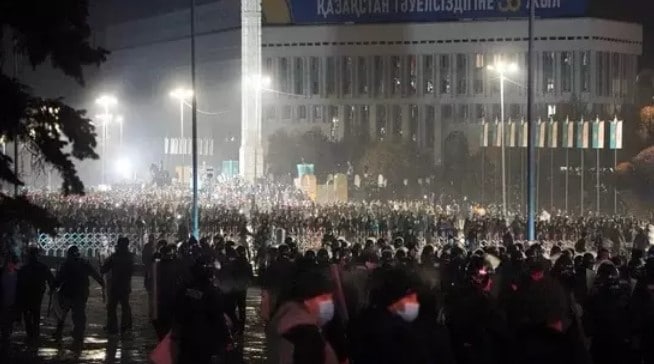
Today, opponents of the protests are using the same tactics. In liberal circles, and sometimes in supposedly left circles too, the protests are explained as being the work of «mambets”. This is an insulting term for the non-Russian speaking, Kazakh youth from rural areas — who, the word suggests, are uncultured, uneducated red-necks. In the last two decades, many Russian speakers, who were the majority of factory workers, returned to Russia. Their place has been taken by young Kazakhs, many of whom have been driven to the cities by the collapse of the rural economy. They are now the backbone of what organised, and militant labour there is in Kazakhstan.
Of course, in Russian nationalist circles, this is seen as a chance to extend the Kremlin’s influence across Central Asia. One deputy from Putin’s party has even suggested that there should be a referendum in Kazakhstan to merge with Russia. Others speculate that Putin could use the opportunity to intervene on the pretext of defending the ethnic Russians living in the country. But this uprising has been a nasty shock for the Kremlin. It has already had to deal with Belarus, and is facing a showdown over Ukraine.
If it was to intervene “in defence of ethnic Russians”, it would be restricted to a few regions along the Northern and Eastern boundaries. It would cut itself off from 80–90% of regions in which only a very small percentage of Russians are living, including the main oil and gas fields. If this were to happen there would be an even stronger anti-Russian mood amongst Kazakhs, and far more likelihood of the country falling more under Chinese patronage.
For fear of discontent spilling over into Russia, the Kremlin has already been forced to intervene to prop up the central government. As in Belarus, whoever stays in power will by more indebted to the Kremlin. At the same time by siding with this unpopular regime, Russia will find that the majority of Kazakhs will become even more hostile to the Kremlin than they now are. Unless Russian “peacekeeping” troops are withdrawn quickly, with time Kazakhs will begin to look on them as occupiers.
What way forward?
At a certain stage there will have to be some form of breakthrough to one side or another in this movement. The worst outcome of course, is for the movement to retreat and the police, army backed by the CSTO forces to restore order and the status quo. There have already been many killed, overwhelmingly by the state forces. If this was to happen the minor concessions that have been promised will be wound back and repression will become more widespread.
If the movement is able to develop further, it could gain more concessions. To do this it needs to be more organised, with democratically elected structures to coordinate and lead activities, with clearly defined demands.
Within Kazakhstan a key role could be played by extending the strikes that are already taking place, into a national general strike called perhaps jointly by the oil-workers, and those at KazakhMys and Arselor-Mittal. Internationally, the example of those who protested in Kyrghyzia against participation in the CSTO actions if followed could force an end to the military intervention in support of the government.
If then the movement succeeds in forcing out of office Tokayev and Nazarbayev, the question arises what should replace them? Demands have been put forward by another group of workers that includes, apart from the resignation of the government and release of all political prisoners, a reduction in the price of essential goods and utilities; a reduction in the pension age to 58/60; a general increase in wages; the abolition of all daughter [outsourced] enterprises of nationalised companies; an increase in minimum pensions and childcare.
We support all of these demands, but how are they going to be achieved? Firstly, none of the current opposition leaders the like of Ablyazov or Kazhegeldin can guarantee them. Not only are they supporters of the capitalist system. They have already demonstrated that in power they too have their noses in the trough. They look after the elite at the expense of ordinary people. Secondly, if a new government came to power and wanted to implement these demands, it would have to be prepared to expropriate the riches of the elite, nationalise the oil, gas, key corporations, and other valuable resources and plan the economy under democratic workers’ control.
Whatever the outcome of the next few days, two questions arise. Is it possible now to strengthen the organisation demonstrated in Zhanaozen on a democratic and permanent basis, and extend the workers movement nationally? Is it now possible to politicise the workers movement with a socialist programme, which needs as a first step the formation of a firm revolutionary socialist organisation in Kazakhstan? ISA believes the answer to both these questions is that yes, it is not only possible, but absolutely essential. If you agree with us, Join us.

